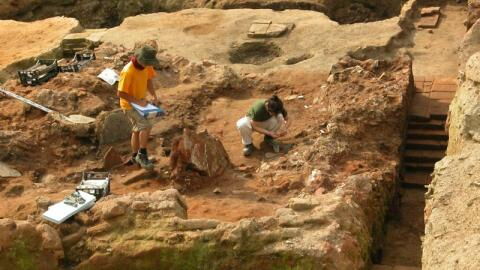They are almost the same age and have a similar form, but are separated by several thousand miles. The famous Pyramid of Khufu has found its rival in grandeur far away from the Egyptian desert where it has towered proudly for over 4500 years. An immense pyramid has been uncovered in China, a region which has been reputed for its temples and monasteries.
Discover our latest podcast
As revealed by an article which appeared a short while ago in the journal Antiquity, it’s really just a stone’s throw -- or rather a few Li -- from the Great Wall that the impressive monument has been discovered. Built a few centuries after its Egyptian counterpart – around 4300 years ago – the Chinese pyramid somewhat surpasses the ambitions of the one in Giza. At least in terms of the area covered: with a base of around 24 hectares, it extends over a surface area which is four times as large.
In terms of height, it’s the Egyptian masterpiece which has the upper hand. The Chinese pyramid, with around 230 feet between its base and its summit, is half as tall as the one in Egypt which holds the tomb of the pharaoh Khufu. The Chinese monument does not share this funerary function.
A place for the elite to live and work
The archaeologists reveal in their publication:
Evidence [collected] so far suggests that the pyramid complex functioned not only as a residential space for ruling Shimao elites, but also as a space for artisanal or industrial craft production.
These hypotheses were elaborated through observation of the very particular structure of the Chinese pyramid.
It consists of eleven level-stepped storeys, all bordered by a row of rocks, the tallest of which revealed information-rich remains. The scientists wrote:
There were extensive palaces built of rammed earth, with wooden pillars and roofing tiles, a gigantic water reservoir, and domestic remains related to daily life.
Imposing fortifications also protected the pyramid entrance, ‘whose design suggests that they were intended to provide both defence and highly restricted access.’ Besides these purely functional architectural elements, esoteric signs were discovered on the Chinese pyramid by the specialists: a series of symbols in the form of an eye and faces of half-animals half-humans. The researchers stated:
These forms may have endowed the stepped pyramid with special religious power and further strengthened the general visual impression on its large audience.
One of the largest cities in the world
A large audience is an understatement. For five hundred years, there was a prosperous town at the foot of the pyramid. And it wasn’t small either: there were 4000 properties at its peak, all spread out across an area of around 400 hectares, ‘one of the largest in the world’ at the time, archaeologists reckon. The town is now called Shimao, but its original name is unknown, and will probably remain so forever.
Its inhabitants did not have the most pacifist customs if we are to believe the other discoveries made by the experts. They revealed:
In the outer gateway of the eastern gate on the outer rampart alone, six pits containing decapitated human heads have been found.
This rather morbid discovery is an eloquent testimony to the rivalry with the neighbouring site of Zhukaigou, situated north of Shimao. The archaeologist concluded
Morphological analysis of the human remains suggests that the victims may have been related to the residents of Zhukaigou, which could further suggest that they were taken to Shimao as captives during the expansion of the Shimao polity.
These prisoners were probably sacrificed for religious reasons, a theory confirmed by the jade objects found here and there in the structure of the pyramid.
While for some time it was believed that the town was part of the Great Wall of China, analyses and archaeological dating have shown that it is much older than that. But we are far from knowing all the secrets held within the site. While the Khufu pyramid no doubt also holds its own mysteries, there are innumerable other enigmas for archaeologists to make sense of after the discovery of its mysterious Asian counterpart.















